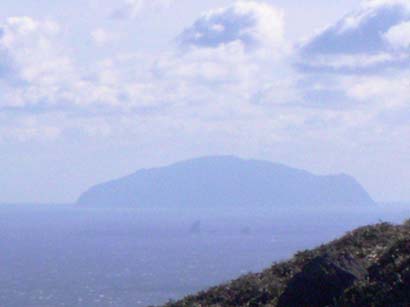Study Site: Mikura Island
Mikura Island is a dormant volcano likely thousands of years old. While the near shore area is shallow (4 to 20 m), depths of over 100 m can be found within 150 m of shore. The coast is lined with boulders and pebbles. The Kuroshio current annually encompasses the island in its northerly flow and brings a variety of fish. Due to the deep waters nearby, the effect resembles an upwelling near the island. Thus, fish species are abundant. Dolphins can be seen in the surf zone near Mikura Island as well as in the deeper waters.

Study Site
Mikura Island is a dormant volcano likely thousands of years old. While the near shore area is shallow, depths over 100 m can be found within 300 meters of shore. The coast is lined with boulders and pebbles. The Kuroshio current annually encompasses the island in its northerly flow and brings a variety of fish. Due to the deep waters around the island, the effect resembles an upwelling near the island. Thus, fish species are abundant.
Study Animal
Observations on bottlenose dolphins around Mikura Island have been ongoing since the early 1980’s (Moyer, 1997). Systematic data collection in the form of video and photographic recordings has been conducted since 1994 (T. Iwatani, I.C.E.R.C. Japan, pers. comm., 1996). Work by I.C.E.R.C. and Mikura Bottlenose Dolphin Research Association volunteers estimates the current population size frequenting the waters within 300 m of Mikura shores at about 165 individuals. A 1:1 sex ratio of identified dolphins has been reported, although this ratio does not hold within different age classes. There are many more young males than females and more adult females as compared with adult males. Early analyses suggest that adult females with calves are the most frequent group types observed around Mikura Island (R. Soeda, I.C.E.R.C. Japan, pers. comm., 1997; Moyer, 1997).
Tourists have become increasingly interested in interacting with these dolphins over the past four years. Before 1993, fewer than 5000 people visited Miyake and Mikura Islands for the purpose of swimming with dolphins. In 1997, the number of dolphin-watching visitors has risen to well over 10,000 people per year – mostly from May through October.
Age Classes
Calf/Infant – Dolphins less than 2/3 the length of an adult with which they consistently swim beside or in echelon. Calves were less than one year old and ranged in size from about 0.75 to 1.5 meters in length. Very young calves/infants (< 1 mo. old) had visible fetal folds, slightly folded dorsal fin and fluke tips, and “cork-bobbed” at the surface when breathing.
Juvenile – Dolphins ranging in size between 1.5 and 2.0 meters in length, swimming independently from adults, and often interacting with other similar aged and sized individuals were considered to be juvenile.
Subadult – Dolphins approximately 2.0 to 2.5 meters in length, and without the girth observed in adults. These individuals appear not to have reached sexual maturity. The distinction between older juveniles and subadults and young adults and subadults is difficult and classification is aided by observations of associates and behavioral activity. Once a female sub-adult has a calf, she is assumed to be an adult.
Adult – Dolphins approximately 2.5 to 3.0 meters in length with some degree of ventral spotting present.
